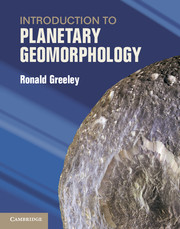Book contents
- Frontmatter
- Contents
- Foreword
- Preface
- Acknowledgments
- Chapter 1 Introduction
- Chapter 2 Planetary geomorphology methods
- Chapter 3 Planetary morphologic processes
- Chapter 4 Earth’s Moon
- Chapter 5 Mercury
- Chapter 6 Venus
- Chapter 7 Mars
- Chapter 8 The Jupiter system
- Chapter 9 The Saturn system
- Chapter 10 The Uranus and Neptune systems
- Chapter 11 Planetary geoscience future
- Appendices
- References
- Further Reading
- Index
Chapter 3 - Planetary morphologic processes
Published online by Cambridge University Press: 05 February 2013
- Frontmatter
- Contents
- Foreword
- Preface
- Acknowledgments
- Chapter 1 Introduction
- Chapter 2 Planetary geomorphology methods
- Chapter 3 Planetary morphologic processes
- Chapter 4 Earth’s Moon
- Chapter 5 Mercury
- Chapter 6 Venus
- Chapter 7 Mars
- Chapter 8 The Jupiter system
- Chapter 9 The Saturn system
- Chapter 10 The Uranus and Neptune systems
- Chapter 11 Planetary geoscience future
- Appendices
- References
- Further Reading
- Index
Summary
Introduction
Earth is a dynamic planet. That simple statement can be supported by our own direct observations. Earthquakes, river banks collapsing during flooding, erupting volcanoes – all are experienced or documented on the news every year and show that our planet is everchanging. These examples represent three of the four fundamental processes that shape Earth’s surface: tectonism, gradation, and volcanism.
The fourth fundamental process, impact, which is generally less often observed, is also documented, sometimes in quite newsworthy events as when a meteoroid plunges through the roof of a house. As the geologic record shows, the history of Earth can be profoundly altered by impacts, such as the well-known Chicxulub structure in the Yucatan peninsula of Mexico. This structure, now buried beneath a kilometer of sediments, has been mapped by geophysical methods and drill-holes to be more than 80 km in diameter and is estimated to have formed from an impact that released the energy equivalent of some 10 billion tons of TNT. The resulting fireball ignited world-wide fires, generated enormous amounts of CO2 from the vaporization of limestone present at the impact site, and triggered tsunamis throughout the Gulf of Mexico and adjacent waters. As is now widely accepted, these catastrophic events led to mass extinctions, including that of the dinosaurs, and marked the boundary between the Cretaceous Period and the Tertiary Period 65 million years ago. It was not so much the direct impact that led to extinctions, but the effects on the surface environment, including firestorms, enhanced greenhouse processes, and disruption of the food chain.
Information
- Type
- Chapter
- Information
- Introduction to Planetary Geomorphology , pp. 34 - 58Publisher: Cambridge University PressPrint publication year: 2013
